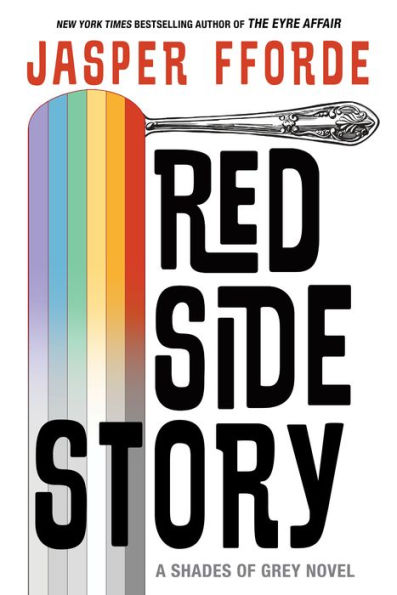Red Side Story
The long-awaited follow-up to the New York Times bestselling Shades of Grey—in an EXCLUSIVE EDITION for North American readers, complete with a never-before-published short story
“Fforde's books are more than an ingenious idea. They are written with buoyant zest and are tautly plotted . . . and are embellished with the rich details of a Dickens or Pratchett.” —The Independent
Welcome to Chromatacia, where life is strictly regulated by one’s limited color perception. Civilization has been rebuilt after an unspoken “Something that Happened” five hundred years before. Society is now color vision–segregated, everything dictated by an individual’s visual ability, and governed by the shadowy National Color in far-off Emerald City.
Twenty-year-old Eddie Russett, a Red, is about to go on trial for a murder he didn’t commit, and he’s pretty certain to be sent on a one-way trip to the Green Room for execution by soporific color exposure. Meanwhile, he’s engaged in an illegal relationship with his co-defendant, a Green, the charismatic and unpredictable Jane Grey. Negotiating the narrow boundaries of the Rules within their society, they search for a loophole—some truth of their world that has been hidden from its hyper-policed citizens.
New York Times bestselling author Jasper Fforde returns to his fan-favorite Shades of Grey series with this wildly anticipated, laugh-out-loud funny and darkly satirical adventure about two star-crossed lovers on a quest to survive—even if it means upending their entire society in the process.
1144181618
“Fforde's books are more than an ingenious idea. They are written with buoyant zest and are tautly plotted . . . and are embellished with the rich details of a Dickens or Pratchett.” —The Independent
Welcome to Chromatacia, where life is strictly regulated by one’s limited color perception. Civilization has been rebuilt after an unspoken “Something that Happened” five hundred years before. Society is now color vision–segregated, everything dictated by an individual’s visual ability, and governed by the shadowy National Color in far-off Emerald City.
Twenty-year-old Eddie Russett, a Red, is about to go on trial for a murder he didn’t commit, and he’s pretty certain to be sent on a one-way trip to the Green Room for execution by soporific color exposure. Meanwhile, he’s engaged in an illegal relationship with his co-defendant, a Green, the charismatic and unpredictable Jane Grey. Negotiating the narrow boundaries of the Rules within their society, they search for a loophole—some truth of their world that has been hidden from its hyper-policed citizens.
New York Times bestselling author Jasper Fforde returns to his fan-favorite Shades of Grey series with this wildly anticipated, laugh-out-loud funny and darkly satirical adventure about two star-crossed lovers on a quest to survive—even if it means upending their entire society in the process.
Red Side Story
The long-awaited follow-up to the New York Times bestselling Shades of Grey—in an EXCLUSIVE EDITION for North American readers, complete with a never-before-published short story
“Fforde's books are more than an ingenious idea. They are written with buoyant zest and are tautly plotted . . . and are embellished with the rich details of a Dickens or Pratchett.” —The Independent
Welcome to Chromatacia, where life is strictly regulated by one’s limited color perception. Civilization has been rebuilt after an unspoken “Something that Happened” five hundred years before. Society is now color vision–segregated, everything dictated by an individual’s visual ability, and governed by the shadowy National Color in far-off Emerald City.
Twenty-year-old Eddie Russett, a Red, is about to go on trial for a murder he didn’t commit, and he’s pretty certain to be sent on a one-way trip to the Green Room for execution by soporific color exposure. Meanwhile, he’s engaged in an illegal relationship with his co-defendant, a Green, the charismatic and unpredictable Jane Grey. Negotiating the narrow boundaries of the Rules within their society, they search for a loophole—some truth of their world that has been hidden from its hyper-policed citizens.
New York Times bestselling author Jasper Fforde returns to his fan-favorite Shades of Grey series with this wildly anticipated, laugh-out-loud funny and darkly satirical adventure about two star-crossed lovers on a quest to survive—even if it means upending their entire society in the process.
“Fforde's books are more than an ingenious idea. They are written with buoyant zest and are tautly plotted . . . and are embellished with the rich details of a Dickens or Pratchett.” —The Independent
Welcome to Chromatacia, where life is strictly regulated by one’s limited color perception. Civilization has been rebuilt after an unspoken “Something that Happened” five hundred years before. Society is now color vision–segregated, everything dictated by an individual’s visual ability, and governed by the shadowy National Color in far-off Emerald City.
Twenty-year-old Eddie Russett, a Red, is about to go on trial for a murder he didn’t commit, and he’s pretty certain to be sent on a one-way trip to the Green Room for execution by soporific color exposure. Meanwhile, he’s engaged in an illegal relationship with his co-defendant, a Green, the charismatic and unpredictable Jane Grey. Negotiating the narrow boundaries of the Rules within their society, they search for a loophole—some truth of their world that has been hidden from its hyper-policed citizens.
New York Times bestselling author Jasper Fforde returns to his fan-favorite Shades of Grey series with this wildly anticipated, laugh-out-loud funny and darkly satirical adventure about two star-crossed lovers on a quest to survive—even if it means upending their entire society in the process.
29.95
In Stock
5
1

Red Side Story
480
Red Side Story
480
29.95
In Stock

Product Details
| ISBN-13: | 9781641296281 |
|---|---|
| Publisher: | Soho Press, Incorporated |
| Publication date: | 05/07/2024 |
| Series: | Shades of Grey Series , #2 |
| Pages: | 480 |
| Sales rank: | 19,347 |
| Product dimensions: | 9.10(w) x 6.30(h) x 1.60(d) |
About the Author

From the B&N Reads Blog
